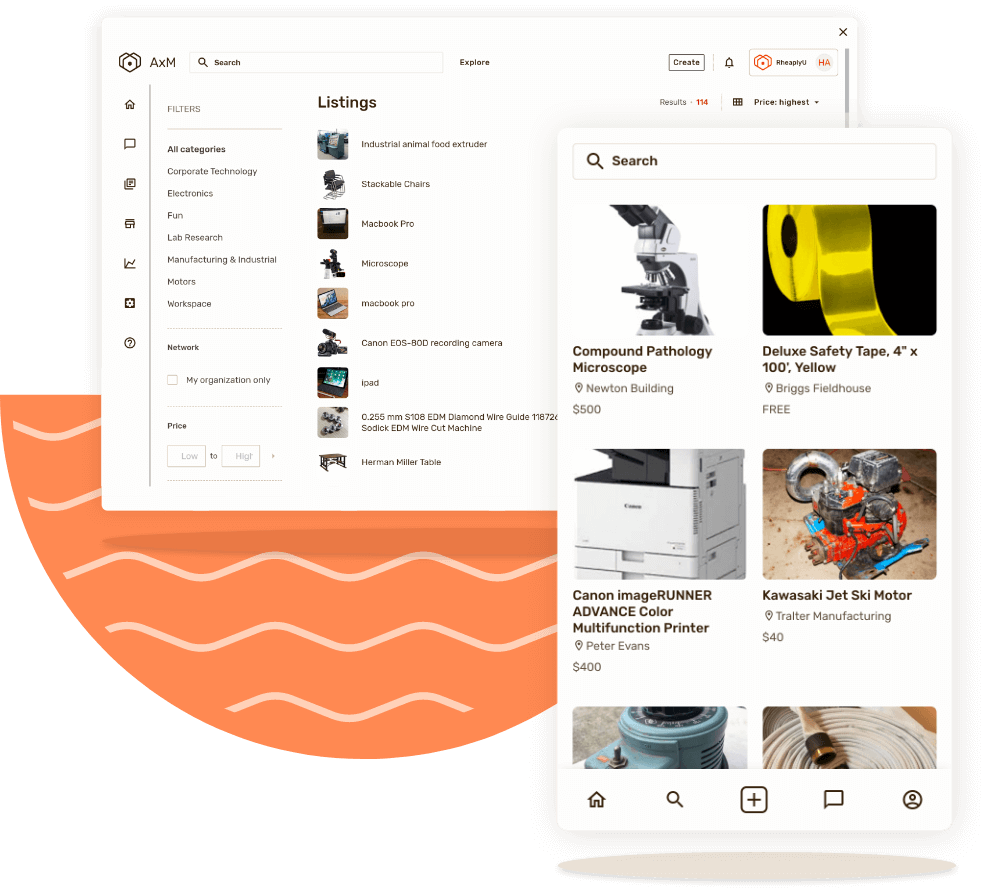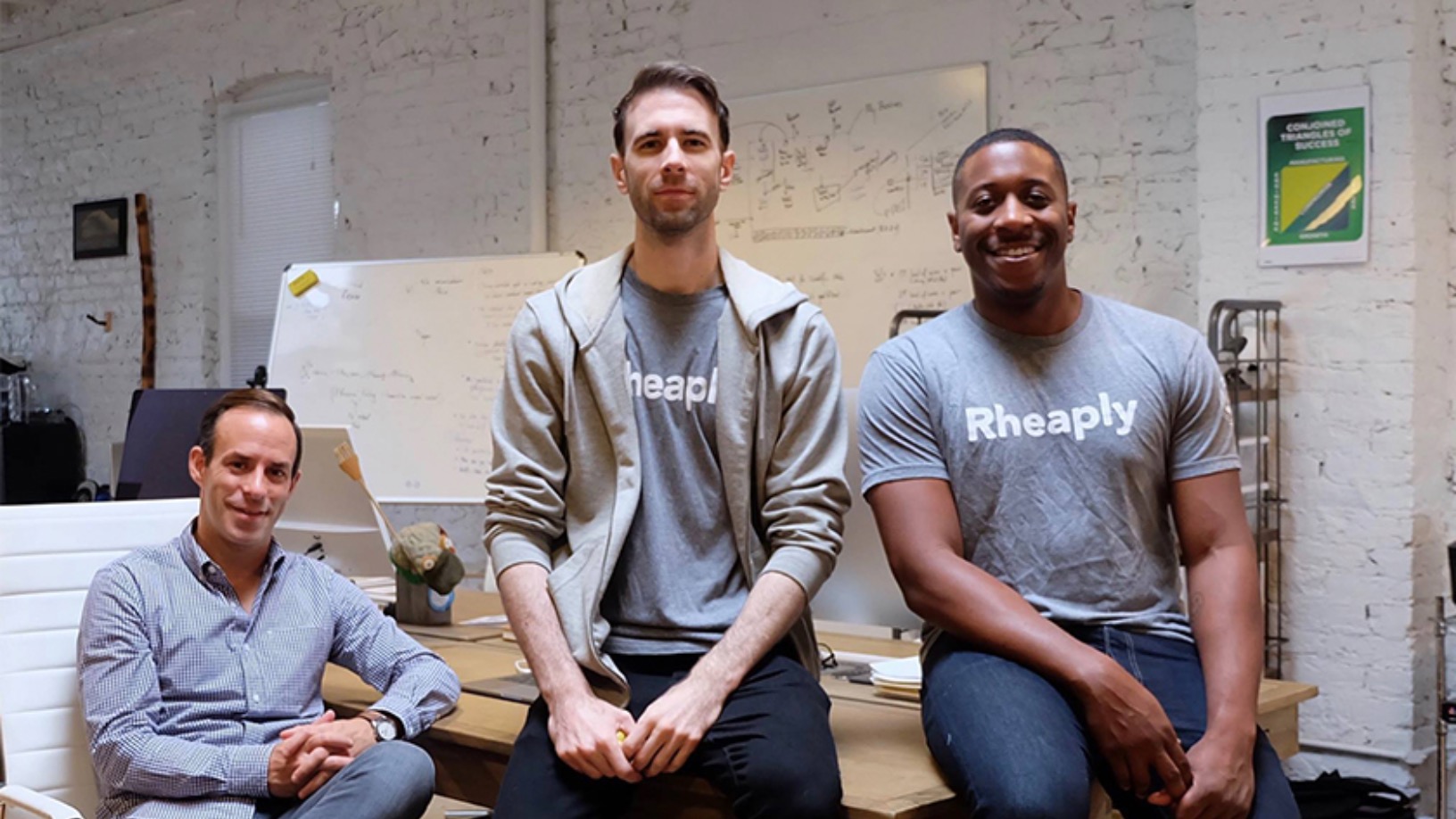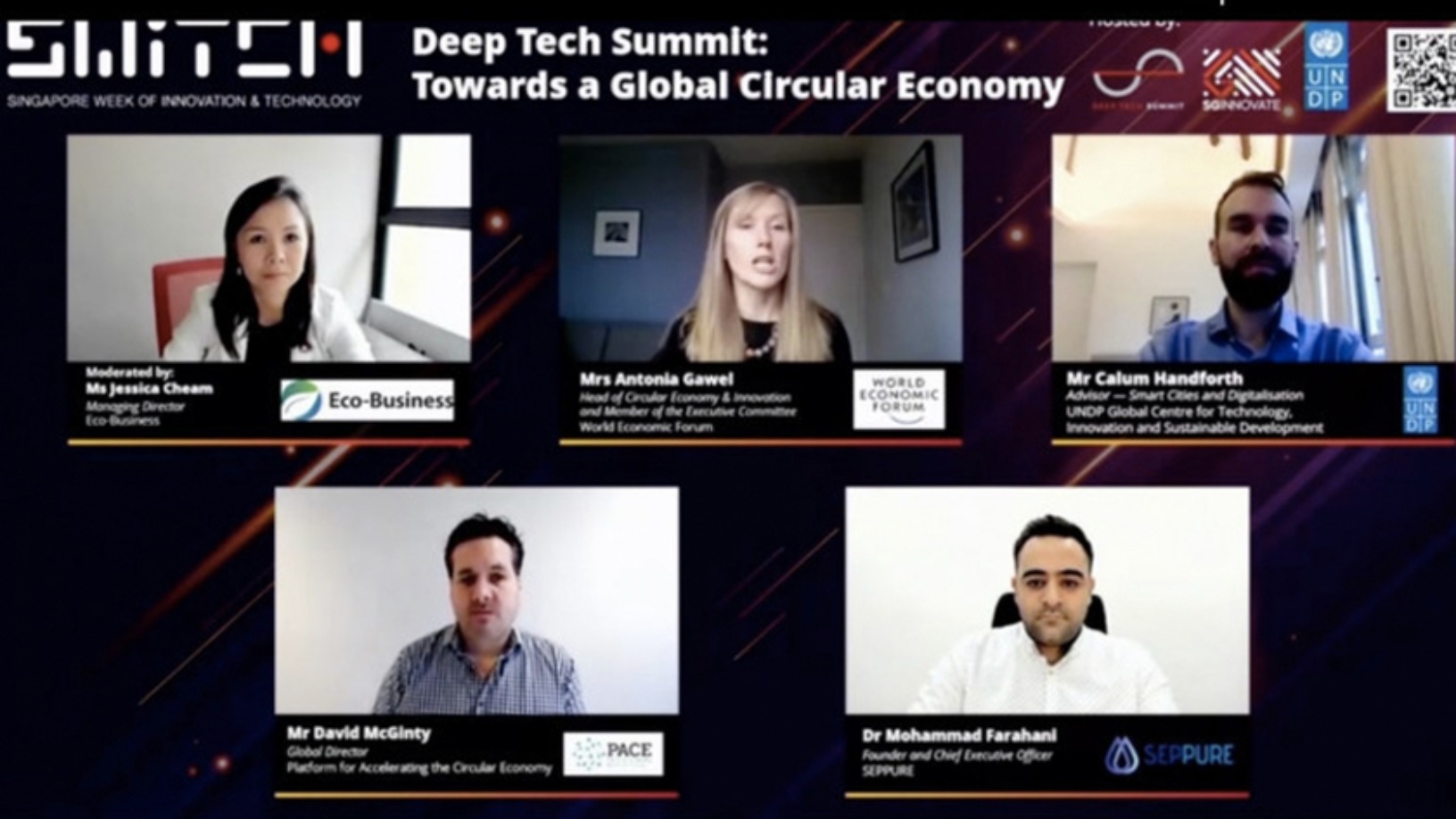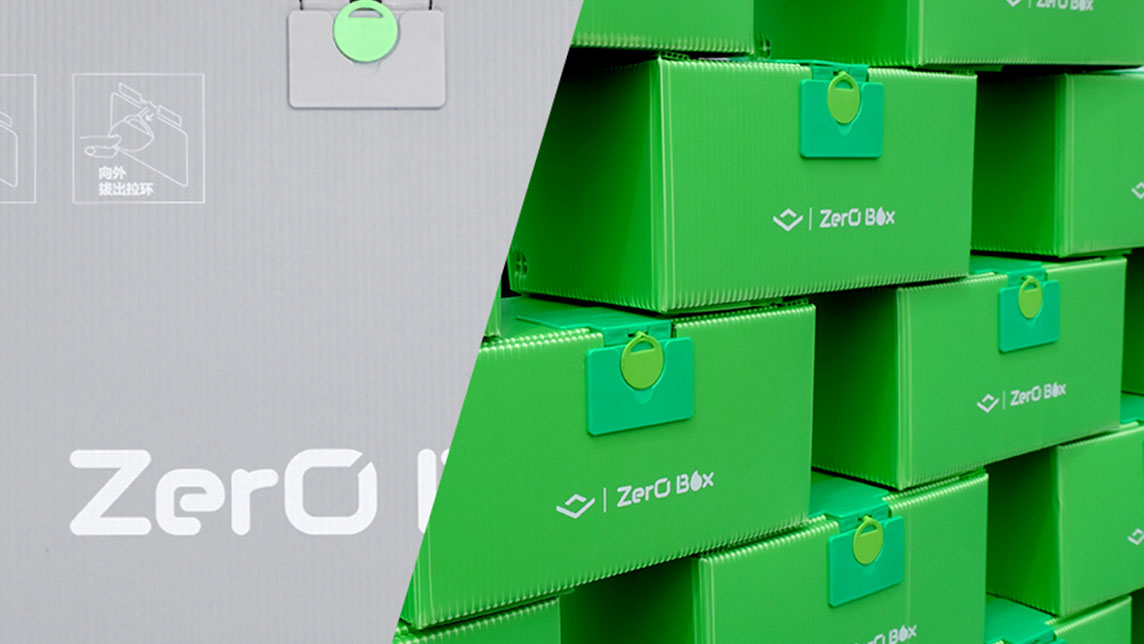Recycling is now a common word in corporate and consumer lexicon, but its logical precursor, reuse, while enjoying some success among individuals, is in its infancy at the industrial and corporate levels. Rheaply – a circular economy asset management platform and second-hand marketplace – is pioneering B2B reuse across all business sectors. It even employs gamification to encourage reuse among employees.
Founded in 2016 by CEO Garry Cooper, who has a PhD in neuroscience, and developers Tyler Skelton (CPO) and Peter Tucker (CTO), Rheaply’s SaaS platform called Asset Exchange Manager (AxM) facilitates the giving away, lending or selling of virtually any kind of unwanted workplace assets, which it advertises to under-resourced companies needing equipment or services that they often cannot afford to buy.
The platform also acts as an asset catalog for corporates that may have millions of items across hundreds of buildings and whose own staff often may not know if the equipment they need is even on-site, let alone in another building.
Rheaply has grown quickly and today has 22 staff. It recently closed a Series A funding of $8m. It was runner-up at the 2020 Web Summit pitch competition out of 700 entrants. Its other accolades include the Circular Economy Leadership Award in 2019 and 2020 by US NGO, the Sustainable Purchasing Leadership Council.
CompassList recently interviewed Cooper about the potential impact of Rheaply in the circular economy, the inspiration behind the concept, its development and business model.
Q. How did a PhD in neuroscience come to establish a circular economy reuse marketplace?
A. Like many people who are in sustainability, I spotted something that I realized had to change. When I was finishing my PhD in neuroscience at the Northwestern University here in Chicago, I noticed that my laboratory had lots of material, ranging from microscopes to chemicals, that we weren't using and in fact never did. Meanwhile, I had lots of friends in my PhD program who were in labs that were smaller than mine and lacked equipment. So I got permission to start sharing the resources. Demand grew and grew and people started sharing from other departments too.
It made me realize a bigger opportunity. If we could make sharing or reuse in a large sprawling organization like a university easy and could use technology to help scale, it might also be a solution for many other organizations. My best friend, now one of my co-founders, who was a senior developer in a very successful company before Rheaply, and who hated all the ideas I ever pitched, actually agreed to join me. We worked nights and weekends for a year just researching, and in November 2016, we launched Rheaply.
Can people exchange or buy and sell literally any product or service on Rheaply?
People mainly can trade universal workplace assets like chairs and tables down to very specific items like chemicals and antibodies. We cannot trade anything that's controlled by the government like flammable or corrosive materials. People's skills and time are also tradeable assets in Rheaply.
In order for Rheaply to power reuse, you have to have a platform that lists more or less everything that your organization owns, so that your employees know what's available for them to use plus enable them to have access to the items. If you don't have those two ingredients, an organization cannot power reuse. Rheaply enables you to create internal reuse within your company and when you don't need those things anymore, you can sell or donate to organizations nearby.
Rheaply is mainly directed towards two positions: procurement and sustainability, Every business should be thinking about how to reduce costs without reducing headcount. By definition, reuse is a less consumptive model. On the sustainability side, every company has, for 2030 or 2040, a zero waste to landfill target. Recycling is the least good thing in sustainability; the next best thing to do is reuse but there's not been a lot of research on it. Companies are trying to figure out how to move their business operations to net zero and allow their business to flourish as a for-profit. Rheaply is a technology for business operations in the circular economy. We can also audit for customers or arrange partners to do that for those who do not have the capacity.
What other functionality does it have for the end-user?
Rheaply also provides an asset management system allowing the tracking of business metrics like depreciation. In addition to a complete equipment like a microscope, our objective is to boost the reuse of parts. Spare parts have a major role in reuse because they keep items in use longer. In order to boost the use of parts, we have a smart tagging system. So, if I search for a microscope in Rheaply, not only will the results return microscopes in the platform, it will return things that are related to microscopes, like its parts.
Secondly, if you think about circularity, the easiest loop is closest to you. If I have a microscope, and I'm in a certain team or department, the easiest thing is for one of my team or department members to reuse it, then someone in another department or building, until finally, if still not reused, then it can go to another city and then a different state. Our tool facilitates this in a scheduled manner. If I post an item, then the closest people see it first and those outside my immediate circle see it later.
In terms of transportation, in the past, it has mostly been arranged by the clients themselves. Now, we are in talks with a couple of key partners, to actually have a robust end-to-end solution with storage, logistics and cleaning, hopefully by the middle of this year.
How long did it take you to build the platform and launch?
We had an MVP while I was still working at Northwestern, which is where I first saw the problem. We launched a pilot in May 2017, about six months after founding. We ran that proof of concept through the end of 2017 and, with that, we got covered in Nature, the world's most prestigious scientific journal. When we got into Techstars [a Colorado-based seed accelerator] in 2018 and got Google as one of our first major corporate clients, when we were still three people, we added a full suite of admin controls. Before, it was just a reuse program with no way for users to control what was being used or to get data insights. In early 2018, we built the admin panel and have since added payment methodology, so you can now actually pay in real-time with Stripe.
How do you encourage staff not in purchasing or sustainability to consider reuse?
Not everyone in a business can purchase and sell things on behalf of the business but the aim is for everyone to be reusing assets. So, in aiming to scale across different organizations, it has been a game-changer to gamify the whole platform. As employees reuse within their company, they earn points and can see how they rank against their colleagues. Each month we give out a monetary gift to the top points earner at every client site. We are also about to bring in carbon reuse, which will be the first time that carbon has been ever related to reuse.
We have worked with Skanska, the largest general contractor in North America. They commissioned this tool we built called DC Three, which basically helps them measure the built environment and embodies carbon metrics. Another initiative is when a customer makes a transaction. I want to use some of the money to buy trees and transact carbon. We have a budding partnership with Salesforce and of course Salesforce CEO Marc Benioff is the leader of the One Tree Project and we're going to do the initiative formally with them.

How does your business model work?
We are a SaaS company with pricing based on the number of buildings that a company has. We work with small companies like charities and small universities, and we also work with massive organizations like the US Air Force and Google. The fee is per company, so workers can use Rheaply at no cost. We also take a transaction fee only when material moves from one organization to another and if it’s a sale or rental. We are getting close to having a business model with zero SaaS fees. If a company is driving a lot of external transactions or external rentals, meaning they're being a good corporate citizen, we will soon be freeing them from SaaS fees. There's no other company doing that in our space.
Any examples of small organizations being able to access assets that would have been impossible without Rheaply?
Absolutely. In Chicago, there's a nonprofit organization called Plant Chicago where they have different sustainable food vendors under one roof. A lot of those food and beverage manufacturers use laboratory material. Another client, the University of Chicago, had items worth millions of dollars that they weren't using anymore and were going to throw them away. So, we allowed Plant Chicago to access [University of Chicago’s] resources without having to pay and without having to go far.
In this world, we actually have all the material we need to do everything that we want to do. The problem is we don't know where any of it is. So, we do the most convenient thing, we just go purchase a new item and companies have made it so easy to do that. Rheaply can shift that unsustainable behavior just by using really simple, easy to use software and connecting willing partners.
Could you tell me about the metrics?
On the platform today, we have 30–40 organizations but as paying customers, I think we have 18 or 19. By March 2021, we'll probably be somewhere north of 50–60 organizations and maybe 25 paying customers. In terms of impact, we have, to date, saved 14.5 cubic tons of waste ending up in landfill. In the US, right now in the corporate sector, it's estimated that about 60m tons of waste that otherwise could be used will go to landfill.
How did you manage to get customers like Google on board so early on, and, have you expanded outside of Illinois yet?
Firstly, what Rheaply is doing is new and is not being done by any other company. Secondly, I think it is by just being passionate, being vocal, networking and having conversations and trying to learn. I also went to lots of conferences, and, quite frankly, Google reached out to us. Google like every other company has lots of storage warehouses, but no one knows what's in the stores. And they're paying $30,000–$40,000 a month per warehouse to store things, so the business case kind of writes itself and people just reached out.
We work across the US and also in Hong Kong and we are starting to work in South America. We're still looking for our first envoy in Europe, which is ahead of the US in the sustainability game. After the fundraising that we're doing right now, we’ll look to have an expansion into Europe soon.
Actually, I was going to ask about financing...
In the first three and a half years after launch, we raised just under $1m and we've been very, very frugal, as we should be. In February 2020, we closed a $1.63m seed round and that was led by the most prolific investor here in Chicago called Hyde Park. We also had participation from a group called M25 and TechStars and a couple of well-known Chicago ambassadors. So, it was a Chicago round, plus Concrete Rose, which is in Silicon Valley. In March, of course, Covid happened and I thought, strategically I should stay with our business plan. I know a lot of CEOs are doing pullbacks, layoffs and furlough. My thinking was that one should not pull back during a climate crisis, so we stayed open.
We are now closing our Series A and asked for $6m–$8m and I'm happy to report that we got $8m from investors we cannot yet announce. What's most exciting is, outside of our lead investor, which is a stalwart in SaaS, the other investors are all sustainability funds.
If Rheaply were to become huge like Amazon, what would that mean for the world?
Never again would governments or mayors have to ask where all the PPE [personal protective equipment] and ventilators are. There'll be a system to know where the actual things that are not being used are and you can query that in an emergency. In fact, back in June 2020, we did a big project with Mayor Lightfoot here in Chicago around using our core technology to connect PPE vendors locally to businesses looking for PPE. And obviously, that was when the world was…..everyone was, looking for PPE.
Right now, businesses, supply chain leaders and procurement leaders are forced to only think about purchasing; they can't think of re-use. We are the game changer, almost like a Google for physical assets.














